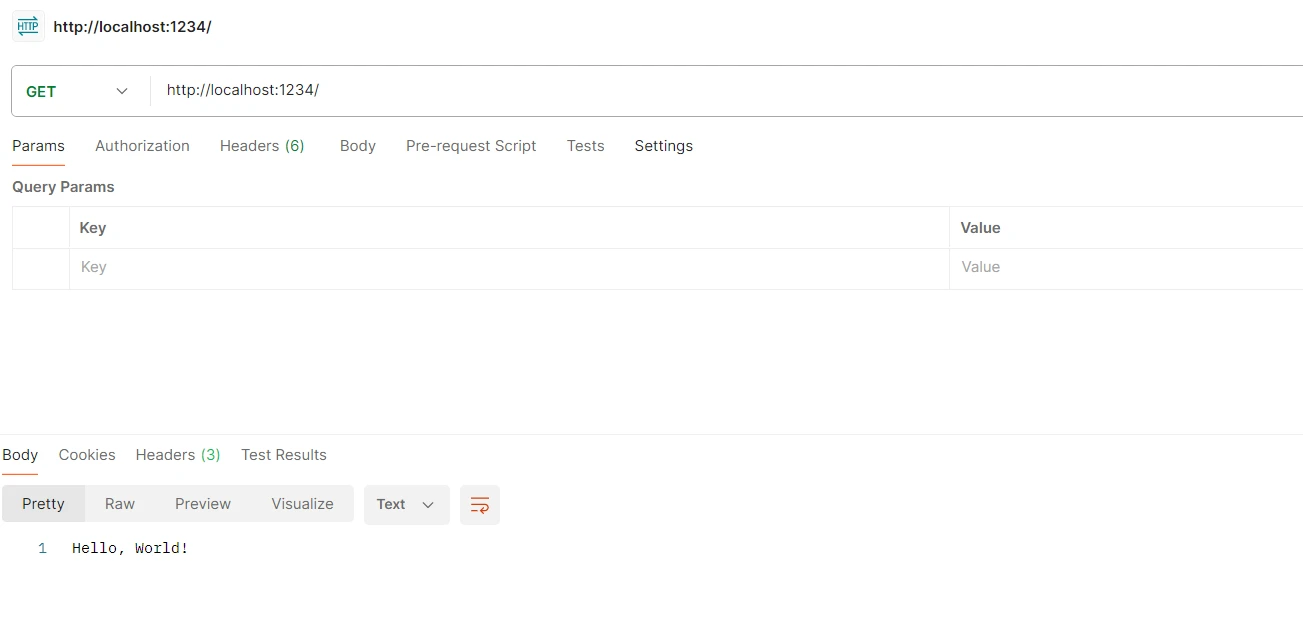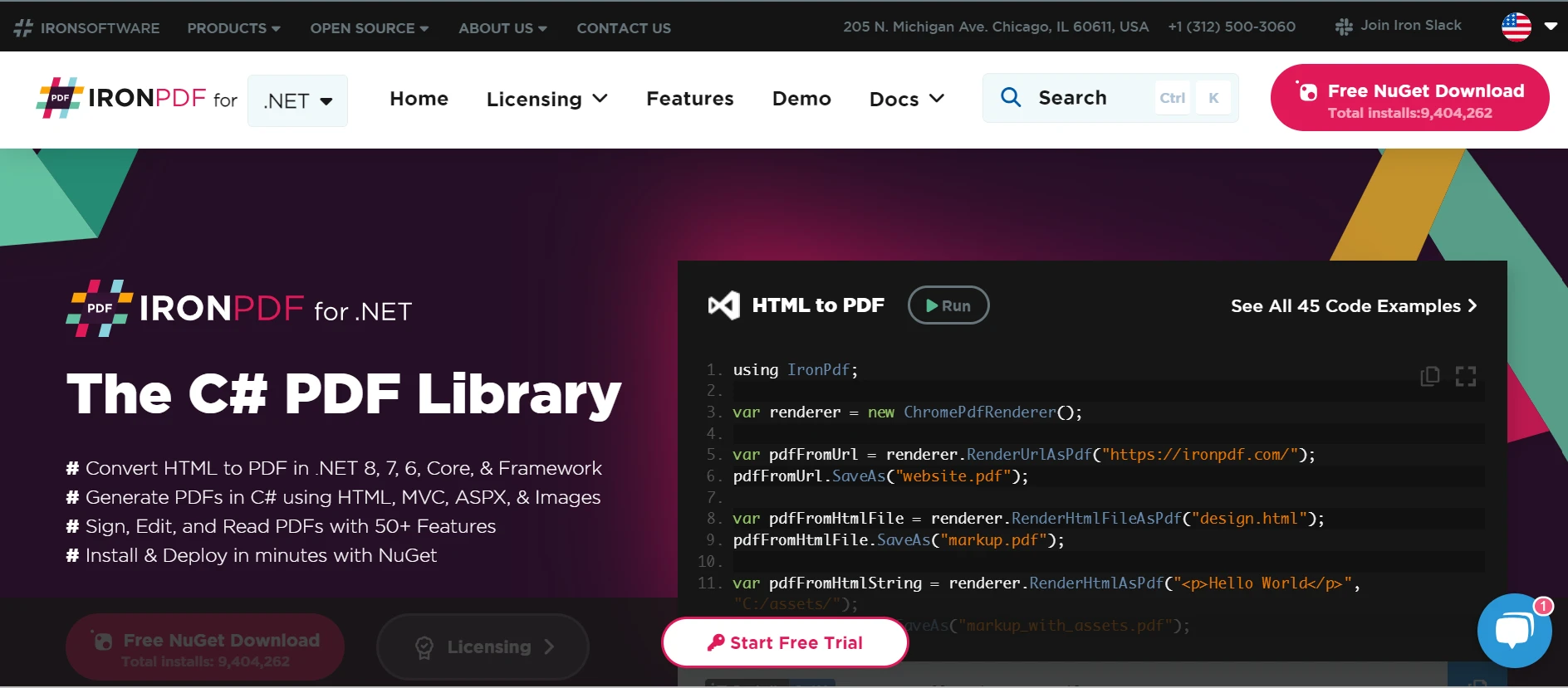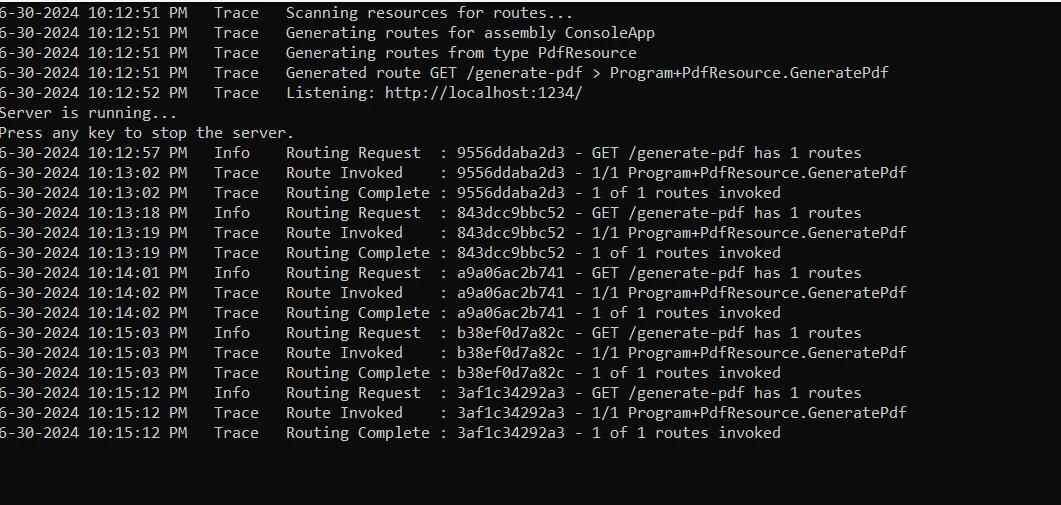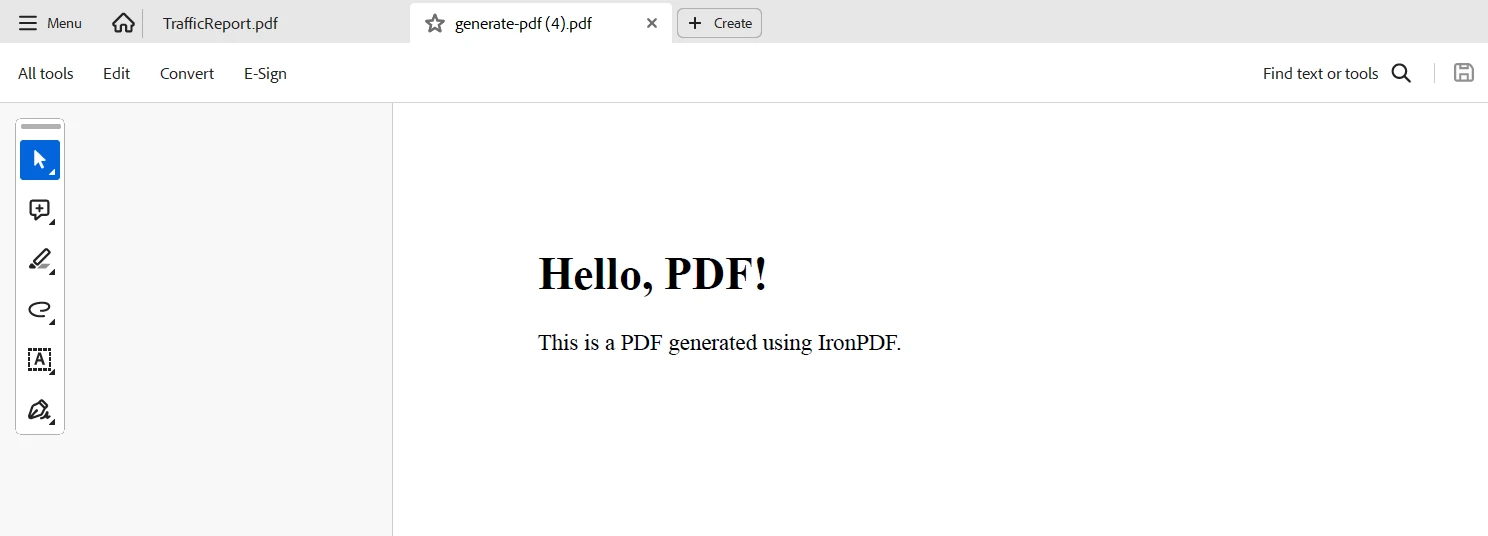Test in production without watermarks.
Works wherever you need it to.
Get 30 days of fully functional product.
Have it up and running in minutes.
Full access to our support engineering team during your product trial
Grapevine is a straightforward yet effective C# micro web framework. It gives programmers a quick, easy, and adaptable approach to build RESTful web services. Grapevine is perfect for small projects and prototypes because of its scalability and ease of use, but it is also strong enough to handle more complicated applications.
With the help of the well-known .NET package IronPDF, programmers may generate, modify, and extract content from PDF documents. IronPDF's extensive feature set makes it easier to work with PDFs in C# applications, which makes it a vital tool for many developers.
By enabling smooth PDF creation and manipulation within your online services, combining Grapevine and IronPDF can greatly improve your C# web applications. This connection provides an effective way to create invoices, reports, or any other kind of document.
A lightweight, quick, and adaptable RESTful web service and API can be created with the help of Grapevine, a C# micro web framework. It is perfect for tiny projects, prototypes, and microservices that need to handle HTTP requests efficiently because of its use of simple patterns and basic architecture, which guarantees fast setup and great performance.
Grapevine makes the process of identifying and managing endpoints easier by providing a flexible and user-friendly routing mechanism. It makes it easier to create CRUD operations and well-organized RESTful APIs by supporting a number of HTTP methods, including GET, POST, PUT, and DELETE. It also supports middleware, which enables programmers to add more functionality by creating unique components for logging, authentication, and error handling.

Because the framework follows REST concepts, developers can create scalable and reliable APIs. Because of its simplicity and ease of use, it's a great option for developers who need to quickly prototype and launch web services without having to deal with the complexities of larger frameworks. Because of its lightweight design, Grapevine is appropriate for microservices and apps that don't need the overhead of a complex web framework.
Grapevine is appropriate for applications where speed is critical because of its basic design, which guarantees a small footprint and excellent performance.
The framework makes it easier to define and manage HTTP endpoints by providing a simple route configurable and user-friendly routing system.
Grapevine, which was developed with REST concepts in mind, supports a number of HTTP methods, including GET, POST, PUT, and DELETE, making it easier to create reliable and organized APIs.
Custom middleware components, helpful for tasks like logging, authentication, authorization, and error handling, allow developers to expand Grapevine's functionality.
Grapevine is perfect for web service prototyping and deployment because of its simple design, which makes setup and development quick.
Its usefulness in a range of application scenarios is increased by its good integration with other .NET libraries and tools.
Because of the modular design of the framework, developers can incorporate only the features that are necessary to maintain the application's efficiency and leanness.
Grapevine is adaptable for a range of project sizes because, despite its lightweight nature, it can scale to accommodate more complicated applications.
The vibrant Grapevine community offers tools, guidance, and case studies to help developers make the most of the framework.
Because of the framework's broad configuration choices, developers can alter the rest server and the settings to meet their own requirements.
Setting up the development environment, installing required packages, and configuring the Grapevine framework are some of the stages involved in creating and configuring a Grapevine C# project. Here's a step-by-step tutorial to get you going:
Get your command prompt or terminal open.
Launch the newly created .NET console application by typing
dotnet new console -n GrapevineExample
cd GrapevineExampledotnet new console -n GrapevineExample
cd GrapevineExampleIRON VB CONVERTER ERROR developers@ironsoftware.comAdd the Grapevine package to your project
dotnet add package Grapevinedotnet add package GrapevineIRON VB CONVERTER ERROR developers@ironsoftware.comusing Grapevine;
using Grapevine.Interfaces.Server;
using Grapevine.Server;
using Grapevine.Server.Attributes;
using Grapevine.Shared;
public class Program
{
public static void Main(string[] args)
{
var server = new RestServer();
server.Start();
Console.WriteLine("Server is running...");
Console.WriteLine("Press enter to stop the server.");
Console.ReadKey();
server.Stop();
}
}
[RestResource]
public class SampleResource
{
//test route method
[RestRoute(HttpMethod = HttpMethod.GET, PathInfo = "/hello")]
public IHttpContext HelloWorld(IHttpContext context)
{
context.Response.SendResponse("Hello, World!");
return context;
}
}using Grapevine;
using Grapevine.Interfaces.Server;
using Grapevine.Server;
using Grapevine.Server.Attributes;
using Grapevine.Shared;
public class Program
{
public static void Main(string[] args)
{
var server = new RestServer();
server.Start();
Console.WriteLine("Server is running...");
Console.WriteLine("Press enter to stop the server.");
Console.ReadKey();
server.Stop();
}
}
[RestResource]
public class SampleResource
{
//test route method
[RestRoute(HttpMethod = HttpMethod.GET, PathInfo = "/hello")]
public IHttpContext HelloWorld(IHttpContext context)
{
context.Response.SendResponse("Hello, World!");
return context;
}
}IRON VB CONVERTER ERROR developers@ironsoftware.comThe first step involves importing the required namespaces from the Grapevine library, which helps with HTTP request handling, routing, and server operations. The Main function in the Program class creates and launches a RestServer object. This server keeps an eye out for new HTTP requests.
The user is informed via the console that the server is up and running and will terminate if any key is pressed. An endpoint is defined by the SampleResource class, which is identified by the [RestResource] attribute, here you could also use a method like public async task test to ensure smooth response times. The [RestRoute] attribute designates the HelloWorld function, which responds to GET requests made at the /hello location. The following output shows the result of this.

Upon successfully hit on the endpoint, the method uses the IHttpContext parameter to return a "Hello, World!" response to the client, along with details about the HTTP request and response. This simple configuration demonstrates how to build a single-route, lightweight web server, highlighting Grapevine's user-friendly HTTP request handling in C#.

Setting up a project in which you can use Grapevine to establish RESTful web services and IronPDF to create or modify PDF documents is the first step in getting started with Grapevine and IronPDF in C#. Here's a step-by-step tutorial to get you going:
C# programs may create, read, and edit PDF documents with the feature-rich .NET library IronPDF. Developers may easily convert HTML, CSS, and JavaScript content into high-quality, print-ready PDFs with this utility. Adding headers and footers, splitting and merging PDFs, watermarking documents, and converting HTML to PDF are some of the most important jobs that IronPDF can complete. IronPDF supports both .NET Framework and .NET Core, making it useful for a wide range of applications.
Because PDFs are user-friendly and provide a wealth of information, developers may include them with ease in their products. IronPDF's ability to handle intricate layouts and formatting means that the PDFs it creates as an output closely resemble the original HTML text.

PDF Generation from HTML
Convert HTML, CSS, and JavaScript to PDF. IronPDF supports two modern web standards: media queries and responsive design, this is helpful for using HTML and CSS to dynamically decorate PDF invoices, reports, and documents.
PDF Editing
It is possible to add text, images, and other material to already-existing PDFs. Use IronPDF to Extract text and images from PDF files, merge many PDFs into a single file, split PDF files up into several distinct papers, and add headers, footers, annotations, and watermarks to your PDF pages.
PDF Conversion
Convert Word, Excel, and image files, among other file formats, to PDF, or conversely, convert PDF documents to an image format (PNG, JPEG, etc.).
Performance and Reliability
In industrial contexts, high performance and reliability are desirable design attributes. easily handles large document sets.
Install the IronPDF package to get the tools you need to work with PDFs in .NET projects.
dotnet add package IronPdfdotnet add package IronPdf'INSTANT VB TODO TASK: The following line uses invalid syntax:
'dotnet add package IronPdfIn order for your first server to handle HTTP requests and responses within the program, a Grapevine RestServer instance must be initialized. This is done by running the Program.cs file. Using the rest servers, the server is launched.Start() and stop, as the server indicated, when pressing any key.Pause().
using Grapevine.Interfaces.Server;
using Grapevine.Server.Attributes;
using Grapevine.Server;
using Grapevine.Shared;
using IronPdf;
class Program
{
[RestResource]
public class PdfResource
{
//Route methods
[RestRoute(HttpMethod = Grapevine.Shared.HttpMethod.GET, PathInfo = "/generate-pdf")]
public IHttpContext GeneratePdf(IHttpContext context)
{
var htmlContent = "<h1>Hello, PDF!</h1><p>This is a PDF generated using IronPDF.</p>";
var renderer = new ChromePdfRenderer();
var pdf = renderer.RenderHtmlAsPdf(htmlContent);
var pdfBytes = pdf.BinaryData;
context.Response.ContentType = ContentType.CUSTOM_BINARY;
context.Response.ContentLength64 = pdfBytes.Length;
context.Response.SendResponse(pdfBytes);
return context;
}
}
static async Task Main(string[] args)
{
var server = new RestServer();
server.LogToConsole().Start();
Console.WriteLine("Server is running...");
Console.WriteLine("Press any key to stop the server.");
Console.ReadKey();
server.Stop();
}
}using Grapevine.Interfaces.Server;
using Grapevine.Server.Attributes;
using Grapevine.Server;
using Grapevine.Shared;
using IronPdf;
class Program
{
[RestResource]
public class PdfResource
{
//Route methods
[RestRoute(HttpMethod = Grapevine.Shared.HttpMethod.GET, PathInfo = "/generate-pdf")]
public IHttpContext GeneratePdf(IHttpContext context)
{
var htmlContent = "<h1>Hello, PDF!</h1><p>This is a PDF generated using IronPDF.</p>";
var renderer = new ChromePdfRenderer();
var pdf = renderer.RenderHtmlAsPdf(htmlContent);
var pdfBytes = pdf.BinaryData;
context.Response.ContentType = ContentType.CUSTOM_BINARY;
context.Response.ContentLength64 = pdfBytes.Length;
context.Response.SendResponse(pdfBytes);
return context;
}
}
static async Task Main(string[] args)
{
var server = new RestServer();
server.LogToConsole().Start();
Console.WriteLine("Server is running...");
Console.WriteLine("Press any key to stop the server.");
Console.ReadKey();
server.Stop();
}
}IRON VB CONVERTER ERROR developers@ironsoftware.comA PdfResource class is defined in the Grapevine configuration to manage particular HTTP requests associated with PDF creation. The [RestResource] attribute, when present, indicates that this class has methods that can react to RESTful routes.

The [RestRoute(HttpMethod = HttpMethod.GET, PathInfo = "/generate-pdf")] annotation on the GeneratePdf method within PdfResource indicates that this method responds to GET requests at the /generate-pdf endpoint. Within the procedure:

In conclusion, developers wishing to incorporate web service capabilities with dynamic PDF production within their applications will find a solid solution in the integration of Grapevine C# with IronPDF. The setup and implementation of RESTful endpoints is made simpler by Grapevine's lightweight and user-friendly minimalist web framework, which also makes it simple to have code to process HTTP requests and create custom routes. IronPDF, on the other hand, improves the program by enabling the easy conversion of HTML information into excellent PDF documents, which include JavaScript integration and support for CSS styling.
This connection gives developers the ability to create dynamic, professional-looking PDFs and distribute them, all while making it easier to create interactive, data-driven web services. Together, Grapevine and IronPDF provide a flexible toolbox that satisfies the needs of contemporary online application development, whether for producing reports, invoices, or other document kinds. Through the combination of IronPDF's robust PDF creation capabilities and Grapevine's user-friendly interface, developers can create scalable and effective solutions that meet a wide range of user requirements and corporate goals.
With IronPDF and Iron Software provides the developer with more web apps and functionality as well as more efficient development. It accomplishes this by fusing its basic support with the incredibly flexible Iron Software systems and suite.
Clearly defined license alternatives that are specific to the project will make it easy for developers to select the ideal model. These benefits enable developers to successfully, quickly, and cohesively implement solutions for a wide range of issues.